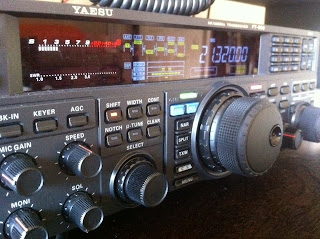 The board meets every last Monday of the month at local landmark, Mission Coffee, on Washington Blvd, just across the Old Mission San Jose church in Fremont. This place has been a favorite hangout/meeting place of almost everyone in Fremont because of its not-so-bad coffee and light fare, and free WiFi.
The board meets every last Monday of the month at local landmark, Mission Coffee, on Washington Blvd, just across the Old Mission San Jose church in Fremont. This place has been a favorite hangout/meeting place of almost everyone in Fremont because of its not-so-bad coffee and light fare, and free WiFi.Amateur radio being a hobby (an OLD one at that), membership in the board is voluntary. It's comprised of people from various professions and from different walks of life. And some are retired, too. This mix allows for an excellent exchange of ideas between newbies and the more experienced hams (a term used to refer to amateur radio enthusiasts). The younger ones bring a fresh perspective and provide new ideas on how to do things, while the senior members share their valuable experiences, as well as some historical insights.
With a new president, the overall goal for this year, in not so many words, is to increase members and participation. This means the club should be able to come up with activities in as many areas of amateur radio in order to attract new members, and maintain and increase participation from the current crop. There are many (many) facets to this hobby, and each one can focus on an activity (or activities) that pleases them.
I didn't want to talk about amateur radio on this blog because it becomes messy, too technical, and may be boring to most of you. I just want to give you a little idea about it, but will not go into specifics.
Personally, my interests are in DXing and contesting. In plain english, DXing (where DX is an abbreviation for "distance") is the ability to contact amateur radio stations all over the world, by voice, morse code, or digital. I always get a kick out of hearing someone's voice or see a typed message displayed on my computer (digital) from across the globe. What makes this fete even more amazing is the fact that the "contact" is done wirelessly, using a transmitting/receiving device, called a high frequency (HF) transceiver/radio. Despite the existence of the internet and mobile phones (and all its applications), nothing beats the thrill of a two-way radio communication.
Contesting, on the other hand, is the art of contacting (or talking to) as many amateur radio stations as possible in a given period of time. And that is putting it in lay man's terms. But contesting is complex (if not complicated), and there are hundreds of contests one can participate in all throughout the year, and in different modes (voice, morse code, or digital). I won't even dare talk about it because it will take us forever.
These 2 aspects of amateur radio are what I want to share with our membership. I suggested creating an interest group in these 2 areas because I think there is not enough knowledge about them or even an exposure to such activities. Part of the task would be to do a presentation on these topics, then put it into actual practice via some sort of demonstration, which will take place in June, during an annual activity called Field Day. This event is participated in my hams all over the US.
Probably, at this point, I am beginning to sound Slovac to you, with all these words and terminologies. So I will stop. But I do want to say that this is an old hobby that has adapted to the modern times. In the US, there has been a resurgence in interest in the hobby, with significant growth in the last year to over 700,000 licensed hams.
You should try it. At least, ready about it. Check out the American Radio Relay League (ARRL).
tnx es 73, NW6J
(thanks and best regards, NW6J)


No comments:
Post a Comment